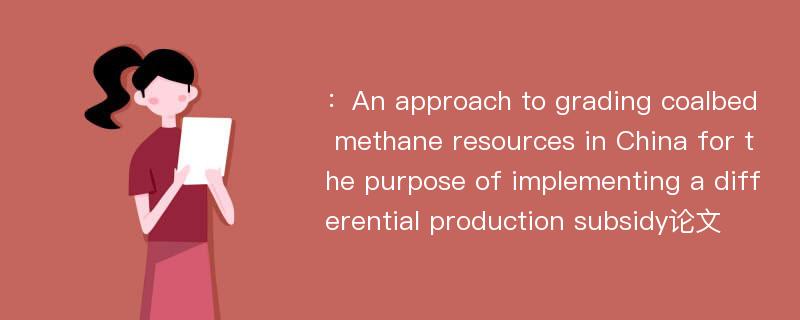
本文主要研究内容
作者(2019)在《An approach to grading coalbed methane resources in China for the purpose of implementing a differential production subsidy》一文中研究指出:The heterogeneity of coalbed methane(CBM) resources was not taken into account when the current indiscriminate subsidy policy was developed. In it, limited subsidy funds are given first to high-quality resources and even to subsidize profitable projects. Thus, the policy has had less than the intended effect in improving CBM production. To implement a new type of differential subsidy, it is necessary to grade the CBM resources, as will be discussed in this paper. After the factors affecting the resources value are systemically examined, sorted and merged, the relationship between the key factors and economic value is analyzed by an engineering economics method, and the production profile type, peak production(or stable production) and buried depth are used as grading factors. The production profile type is used to categorize, and peak production and buried depth are used to grade resources within the same category. The grading method is as follows: use subsidy levels at the economic critical point(NPV = 0) to identify the grades of resources, and determine the combination of peak production and buried depth for different resources grades base on indifference curves drawn according to the relationship between the economic value and peak production and buried depth.
Abstract
The heterogeneity of coalbed methane(CBM) resources was not taken into account when the current indiscriminate subsidy policy was developed. In it, limited subsidy funds are given first to high-quality resources and even to subsidize profitable projects. Thus, the policy has had less than the intended effect in improving CBM production. To implement a new type of differential subsidy, it is necessary to grade the CBM resources, as will be discussed in this paper. After the factors affecting the resources value are systemically examined, sorted and merged, the relationship between the key factors and economic value is analyzed by an engineering economics method, and the production profile type, peak production(or stable production) and buried depth are used as grading factors. The production profile type is used to categorize, and peak production and buried depth are used to grade resources within the same category. The grading method is as follows: use subsidy levels at the economic critical point(NPV = 0) to identify the grades of resources, and determine the combination of peak production and buried depth for different resources grades base on indifference curves drawn according to the relationship between the economic value and peak production and buried depth.
论文参考文献
[1].Characteristics and genetic mechanism of deep-buried clastic eureservoir in China[J]. ZHONG DaKang & ZHU XiaoMin China University of Petroleum,Beijing 102249,China. Science in China(Series D:Earth Sciences).2008(S2)[2].The fracture network model of Shen 229 block buried hill:A case study from Liaohe Basin,China[J]. XING Yu-zhong1,2, FAN Tai-liang1, ZHENG Li-hui2 (1Energy Sources Department, China University of Geosciences, Beijing 100083, China) (2Exploration & Exploitation Research Institute of Liaohe Oil Field Company, Petrochina, Panjin 124010, China). Journal of Zhejiang University Science A(Science in Engineering).2006(11)[3].Complex petroleum accumulating process and accumulation series in the buried-hill trend in the rift basin:An example of Xinglongtai structure trend,Liaohe subbasin[J]. GAO XianZhi1,PANG XiongQi1,LI XiaoGuang2,CHEN ZhenYan2,SHAN JunFeng2,LIU Feng1,ZOU ZhiWen1 & Li WeiLian1 1 Faculty of Resources and Information Technology,China University of Petroleum,Beijing 102249,China; 2 Exploration and Development Institute of Liaohe Oilfield,Petrochina Liaohe Oil Company,Panjin 124010,China. Science in China(Series D:Earth Sciences).2008(S2)[4].The Method for Inferring a Buried Fault from Resistivity Tomograms and Its Typical Electrical Features[J]. Zhu Tao1), Feng Rui1), Zhou Jianguo1), Hao Jinqi1), Wang Hualin2), and Wang Shuoqing2)1) Institute of Geophysics, China Earthquake Administration, Beijing 100081, China2) Shandong Institute of Earthquake Engineering, Jinan 250014, China. Earthquake Research in China.2009(04)[5].Resources Conditions of Coalbed Methane Districts in China[J]. TANG Shuheng China University of Mining and Technology, Beijing 100083and LIN Dayang China National Administration of Coal Geology, Zhuozhou 072752. Acta Geologica Sinica(English Edition).2000(03)[6].Deep Coalbed Methane Development in Eastern Ordos Basin,China[J]. LI Yong,TANG Dazhen. Acta Geologica Sinica(English Edition).2015(S1)[7].Formation of the primary petroleum reservoir in Wumaying inner buried-hill of Huanghua Depression, Bohai Bay Basin, China[J]. JIN Fengming,WANG Xin,LI Hongjun,WU Xuesong,FU Lixin,LOU Da,ZHANG Jinning,FENG Jianyuan. Petroleum Exploration and Development.2019(03)[8].Geothermal field and its relation with coalbed methane distribution of the Qinshui Basin[J]. SUN Zhanxue, ZHANG Wen, HU Baoqun, LI Wenjuan & PAN Tianyou East China Institute of Technology, Fuzhou 344000, China. Chinese Science Bulletin.2005(S1)[9].Methane in soil gas and its transfer to the atmosphere in the Yakela condensed gas field in the Tarim Basin,Northwest China[J]. Tang Junhong,Wang Guojian,Yin Haoyong,Li Hongjun. Petroleum Science.2013(02)[10].Application of Fluid Inclusion Analysis for Buried Dissolution Predicting in the Tahe Oilfield of Tarim Basin, NW China[J]. 阮壮,于炳松,陈圆圆. Journal of Earth Science.2013(03)
论文详细介绍
论文作者分别是来自Petroleum Science的,发表于刊物Petroleum Science2019年02期论文,是一篇关于,Petroleum Science2019年02期论文的文章。本文可供学术参考使用,各位学者可以免费参考阅读下载,文章观点不代表本站观点,资料来自Petroleum Science2019年02期论文网站,若本站收录的文献无意侵犯了您的著作版权,请联系我们删除。
标签:Petroleum Science2019年02期论文;
:An approach to grading coalbed methane resources in China for the purpose of implementing a differential production subsidy论文
下载Doc文档
